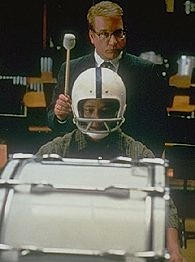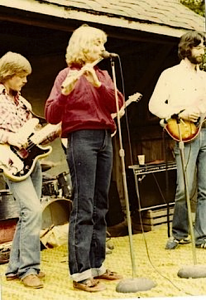Learning by Immersion
Beginning October 7, Nancy Flanagan will co-teach the five-week ecourse STEM & STEAM with MiddleWeb blogger Anne Jolly.
Take piano lessons as a kid? Remember your first lesson—when the teacher placed the red book in front of you and said “this is a whole note?” And from there, it was week after week of whole notes and dotted quarter rests and every good boy does fine? And eventually you either got proficient enough to enjoy actually playing the piano–or quit, because the lessons were so boring?
That’s the way we teach music in secondary schools, too. We give kids shiny new instruments, and they think–Yes! Drumline! School of Rock! And then we open the book, and there’s the whole note and the quarter note. In the most auditory of all disciplines–music–traditional pedagogy focuses first on decoding symbols: visual learning.
We continue to privilege accurate symbolic interpretation in all traditional music instruction–giving highest contest and festival awards to students who are good sight-readers and technicians. Being able to reproduce notated music correctly is an important skill, of course–nobody gets a job with the symphony unless they’re a great sight-reader.
Somewhere along the line, however, other capacities–improvisation, beauty, expression, collaboration, creativity, even pleasure–are submerged in the desire to become what music majors call “a demon reader.” (Music majors amuse themselves by thinking of new mnemonic phrases for every good boy, too–it’s lonely in those practice rooms.)
Classically trained musicians look down on people who “play by ear.” Most secondary music teachers will refuse to teach a complex rhythm or phrase by modeling it, disparaging auditory and kinesthetic means of learning musical skills as “rote.”
That’s how I was trained: the best performance was the one closest to perfect the first time. As a new teacher, selecting beginners, I looked for students reading at grade level or above. When their eyes drifted toward the fingers of the player next to them, I barked “Look at your music!” It was all about the whole notes, quarter notes and not making mistakes. And then–I started playing with Freeman Jones.
A marvelous night for jamming
Freeman Jones was a rock band–really, a bunch of friends from my college days who played guitars and sang together, on Thursday nights. They were looking for a flute player to do Van Morrison’s Moondance. I could also sing, play congas and tambourine–so I was in.
When I showed up, they were jamming on the blues, key of A, and invited me to join in–but I didn’t know how. I knew the theoretical underpinnings of a blues chord progression, but I’d never created a blues melody on my flute. I felt unmoored and self-conscious. When I asked them how many beats to hold the D chord, they said “until it feels right to change.” The bass player was new, too–and he was learning their song repertoire by watching the lead guitar player’s hands.
Nobody in the band could read music. They found the fact that I could write down a melodic line after hearing it interesting–but not particularly useful. Nobody counted, either–they simply felt the rhythmic patterns and flow.
Here’s the thing: Freeman Jones was a good, solid bar band. We played regular gigs, had a loyal following, and over time I learned as much about making music in those Thursday basement sessions as I did in 15 years of formal lessons and music school. And I started experimenting with other ways to teach my students how to play–and enjoy–music.
I discovered that students who heard and copied passages–before deciphering the counting– played with as much confidence and accuracy as those who could place the “ee-and-ah” beat divisions correctly on their music. I figured out that teaching “Let’s Go Blue” by rote (my school is just north of Ann Arbor) was a better instructional strategy for the first week than any method book. And when I saw Mr. Holland hitting that kid on his (helmeted) head with a bass drum mallet–I could totally relate.
Building an experiential base

For most of history, music—like language acquisition—was transmitted by listening, practice and memory. The Suzuki musical training method begins with the idea that music is a universal “mother tongue” which children will absorb quite naturally. While Suzuki students eventually learn to read and play classical literature, they begin by simply playing–easy call and response exercises, little performances enhanced by adult accompaniments.
Many nations approach reading and mathematics pedagogy in the same way. Students learn by being immersed in books, blocks and dramatic play, using tools of the disciplines. Abstract symbolic learning involving phonics and numbers comes later, and rests on a solid base of experiential practice. Other nations skip competitive testing, and rigid, age-leveled expectations for learning, as well.
In the ongoing discourse about personal learning styles, constructivist approaches, and scientifically vetted instructional models that yield the best “results,” I think we can learn a lot from Suzuki. And Freeman Jones.
Nancy Flanagan is a retired teacher with 31 years as a K-12 Music specialist in the Hartland MI schools. She was named Michigan Teacher of the Year in 1993 and is a National Board Certified Teacher. Nancy is co-founder of the Network of Michigan Educators and her popular blog Teacher in a Strange Land is hosted at Education Week Teacher. She served for two years as Teacher in Residence with the National Board for Professional Teaching Standards, working on issues of teacher leadership and education reform.




































